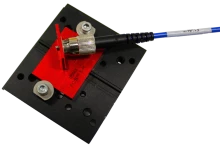FC/B Connector FC Connector At Brewster Angle
Description
Chalcogenide As2S3 and As2Se3 glass fibers offer a broad transmission range with low propagation loss from 1.5μm to 6.5μm and from 1.5μm to 10μm relatively, with high non-linear coefficient, small and negative index change with temperature (dn/dT), excellent power handling capability, and are chemically stable. Transmission cables using these fibers can be fabricated with the known terminations such as: SMA, FC/PC and FC/APC. However, due to the high refractive index of chalcogenide glasses (~2.4 for As2S3, and ~2.7 for As2Se3), the fibers experience a large Fresnel reflection (17% and 21%) at the input and output faces.
For cables with SMA or FC/PC termination this reflection at the input could cause undesirable effects on lasers or other optical components. For applications where this reflection needs to be eliminated isolators must be used. FC/APC termination with 8° angle at the input face does not alleviate the back reflection problems. However, the above termination will still experience lower power being transmitted because of the power loss due to these reflections.
IRflex’s FC/B® termination allows the input beam to be nearly fully transmitted at the input face, which means in addition to eliminating undesirable back reflections, more power is being coupled into the fiber. Our FC/B® connector achieves nearly full transmission and no reflection at the input face by making use of the Brewster angle feature of transmissive materials. Light incident on a material at its Brewster angle will experience no reflection for light with its electric field parallel to the plane of incidence; this is called TM or P-polarization. Light with TE or S-polarization will still experience reflection; as such this angle is also called the polarizing angle.
FC/B Connector FC Connector At Brewster Angle
For pricing, technical or any other questions please contact the supplier
- No registration required
- No markups, no fees
- Direct contact with supplier
-
Ships from:
United States
-
Sold by:
-
On FindLight:
External Vendor

Claim IRflex Corp Page to edit and add data
Frequently Asked Questions
The chalcogenide glass fibers offer a broad transmission range from 1.5μm to 6.5μm and from 1.5μm to 10μm relatively.
Chalcogenide glass fibers have a high non-linear coefficient, low propagation loss, small and negative index change with temperature (dn/dT), excellent power handling capability, and are chemically stable.
The transmission cables can be fabricated with known terminations such as SMA, FC/PC, and FC/APC.
Fibers with SMA or FC/PC termination experience a large Fresnel reflection at the input face, which can cause undesirable effects on lasers or other optical components.
The FC/B® termination makes use of the Brewster angle feature of transmissive materials, allowing the input beam to be nearly fully transmitted at the input face, thus eliminating back reflections.
